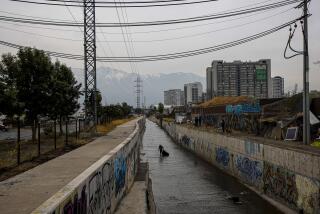The heart and soul of Pablo Neruda
Reporting from Santiago, Chile — It is said that the takeover of Chile in 1973 by Augusto Pinochet broke the heart of Pablo Neruda, the country’s best-known poet.
The man who wrote so openly of love and heartache could not bear to see his country in the hands of a military dictator and died days after Pinochet came to power. After his death, some Chileans said Neruda was spared the agony of seeing thousands of his countrymen killed during Pinochet’s regime, which lasted until 1989.
Revolutions. Dictatorships. Defiance. I wanted to know and understand the frightening, fascinating past of the country I now call home. For me, the best way to do this was to explore the Nobel Prize-winning poet’s three houses — operated as museums by Fundación Pablo Neruda — which reflect Chile’s recent tumultuous history.
It was a hot summer day when I visited La Chascona, a Quechua word meaning disorderly or disheveled, and an affectionate reference to the curly, knotted hair of Neruda’s third wife, Matilde Urrutia. What first caught my eye were the couple’s initials worked in metal on a window exterior. The “P” from his first name created a moon over an ocean, and the “M” from her name created the waves. Everything else about the house also had a nautical appearance, from the porthole windows and low ceilings to the ship-like wooden furniture.
Visitors to La Chascona, in the hills abouve Santago, first enter a combination dining room-bar area. In this home, Neruda actually had more bars than bedrooms. He devoted the space to entertaining guests, including his close friend Diego Rivera. In the dining room, Neruda had a closet where he could quickly change into costumes while his friends ate dinner. Salt and pepper shakers with the words “marijuana” and “morphine” were on the dining table.
Neruda’s passion for collecting was evident here. He loved colored glass and even said that wine tasted better and that water was “less boring” when drunk from colored glass — surprisingly snooty words from someone known as the “people’s poet.”
Neruda also was fond of collecting freakishly large objects. I found it charming that he owned one gargantuan men’s dress shoe and an enormous clock; I learned that shops displayed these objects outside to indicate what they sold. Neruda gathered these items in part as reminders of his hometown of Temuco, in southern Chile, and in part for their comical appeal.
The last room I visited was the library, where many of his books and objects had been destroyed or confiscated by the Pinochet regime because of Neruda’s communist past and his ties to former socialist President Salvador Allende. Urrutia later restored the library.
Days later, I hopped on a charter bus to visit Neruda’s home in Valparaíso, a port town about two hours outside Santiago. The drive was spectacular, passing through the countryside and the many vineyards for which Chile is known. The air smelled sweetly of the fruit growing just a few feet from the road.
Neruda’s house in Valparaíso is high on a hill with expansive windows facing the Pacific. I decided to hoof it up the steep incline rather than take one of the tiny buses that wind their way up — a mistake. I should have shelled out the $1.50 or so to take the bus, and ended up doing so for the ride back down.
La Sebastiana is five stories and filled with as many surprises as La Chascona. Among the oddities: a French carousel horse, bars on nearly every level and a door that leads to a nonexistent helipad. The home is splashed with rich colors: The outside is painted deep blue, and the sitting room is a gaudy pink, decorated with two large golden angels above the doorway.
On the top floor is Neruda’s tiny writing room, which I envied for its view of the ocean, rich wooden furniture and a life-sized photo of Walt Whitman, a writer he admired.
His third house is in the tiny town of Isla Negra, about an hour and a half south of Valparaíso. Neruda gave the minuscule town the name “Black Island,” inspired by the many volcanic-like rocks that speckle its beaches. The house here is perhaps the most interesting of Neruda’s homes, a collector’s paradise where most of his treasures are displayed.
The living room is filled with spooky-looking carved wooden figureheads from old ships. They gave me goose bumps, with more than a dozen pairs of wooden eyes staring at me, so I was eager to head down the hallway to other parts of the house.
Here the poet’s collections bordered on obsession. Masks from around the world and a collection of Chilean waso (cowboy) stirrups lined the long hallway. At the end of the hallway, a special stable had been built for a papier-mâché horse from Temuco — definitely a conversation piece for the man who loved to have wild parties wherever he was.
From Neruda’s upstairs bedroom, he had a view of the deep cerulean ocean, the black rocks on the beach and the fragrant eucalyptus and pine trees. He had carefully placed his bed on a diagonal so that he could see both the trees and the ocean, but his visitors would always try to correct its placement. To keep his guests from changing the layout, he had furniture built around the bed so that it was impossible to move.
Although Neruda wanted to be buried at Isla Negra, Pinochet refused the request and placed restrictions on his funeral. Thousands walked the streets of Santiago alongside his coffin, paying their respects and defying Pinochet.
In 1992, Neruda’s body was moved from Santiago to his Isla Negra home, where he is buried alongside his wife, with their graves facing the ocean and a mast-like headstone befitting a man who loved the sea.
I stood and paid my respects while taking in the spectacular view. I was grateful to Neruda for inspiring me to make this journey and giving me my first glimpse of Chile’s past.
More to Read
Sign up for The Wild
We’ll help you find the best places to hike, bike and run, as well as the perfect silent spots for meditation and yoga.
You may occasionally receive promotional content from the Los Angeles Times.






